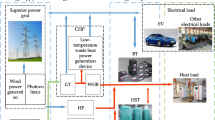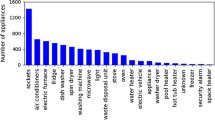Abstract
Energy systems based on renewable energy sources require increasing demand side flexibility. Also, changes in the underlying cost structure, i.e., decreasing variable costs and increasing infrastructure investments as well as varying consumer needs should be reflected in the setup of future markets, including retail markets and tariffs. While various studies focus solely on tariffs with variable energy prices to leverage residential demand side flexibility, we incorporate tariffs with capacity-based price components in our analysis. The latter enable electricity providers to offer more differentiated tariffs, considering individual consumer needs and a balanced cost allocation. To compare the impact of different tariffs on residential demand side flexibility, we develop a bottom-up load model. This model not only simulates but also optimizes residential load profiles in the presence of different tariffs. The model is calibrated based on data from a large-scale field trial. Our results show that tariffs with variable energy prices induce larger demand side flexibility, but the impact of tariffs with variable capacity prices is more predictable and reliable from a suppliers perspective. Potential regulatory adjustments are identified enabling sustainable business models, rewarding demand side flexibility and facilitating the technical implementation.








Similar content being viewed by others
Notes
RELO was used on a computer with the operating system Win Server 2008, two AMD Opteron 6134 processors with 2.3 GHz and 64 GB RAM.
The number of variables and constraints varies significantly depending on the appliance type and its considered shifting ranges, which also affects the computing time. For instance, the optimization of fridges and freezers typically requires about 16 variables and 17 constraints while domestic hot water or space heating requires about 192 variables and 288 constraints. The default configuration of IBM ILOG CPLEX was used.
In many applications, \(\phi ^{PV}\) may be assumed to be zero. However, there may be cases where \(\phi ^{PV}>0\), e.g., if those who live in the house do not own the PV modules but pay a fee for each kWh of PV power as defined in an agreement with the owner of the PV modules.
The number of variables, binary decision variables and constraints differs significantly between shortage situations depending on the appliance types and their shifting ranges. For instance, a model run with 1000 households, a maximum power level restricted over one year and 100% smart households requires approximately from 100 to 17,000 constraints, 30 to 11,000 variables and 30 to 8500 binary decision variables.
The hourly EEX prices for 2011 are available at http://www.eex.com.
References
Ambec, S., Crampes, C.: Electricity provision with intermittent sources of energy. Resour. Energy Econ. 34(3), 319–336 (2012)
Beer, M.: CO\(_2\)-Verminderung in Deutschland. Endbericht. Tech. rep, FfE, Munich (2009)
Bertsch, J., Growitsch, C., Lorenczik, S., Nagl, S.: Flexibility in Europe’s power sector—an additional requirement or an automatic complement? Energy Econ. 53, 118–131 (2016)
Bertsch, V., Schwarz, H., Fichtner, W.: Layout optimisation of decentralised energy systems under uncertainty. In: Operations Research Proceedings 2013. Springer, Berlin, pp. 29–35 (2014)
Bertsch, V., Geldermann, J., Lühn, T.: What drives the profitability of household PV investments, self-consumption and self-sufficiency? Appl. Energy 204, 1–15 (2017)
Broberg, T., Persson, L.: Is our everyday comfort for sale? Preferences for demand management on the electricity market. Energy Econ. 54, 24–32 (2016)
Burger, S., Chaves-Ávila, J.P., Batlle, C., Pérez-Arriaga, I.J.: The Value of Aggregators in Electricity Systems. MIT working paper (2016)
Bürger, V.: Identifikation, Quantifizierung und Systematisierung technischer und verhaltensbedingter Stromeinsparpotenziale privater Haushalte. Freiburg (TRANSPOSE Working Paper, 3) (2009)
Ceseña, E.A.M., Good, N., Mancarella, P.: Electrical network capacity support from demand side response: Techno-economic assessment of potential business cases for small commercial and residential end-users. Energy Policy 82, 222–232 (2015)
Clastres, C., Khalfallah, H.: An analytical approach to activating demand elasticity with a demand response mechanism. Energy Econ. 52, 195–206 (2015)
Destatis, S.B.: Einkommens- und Verbrauchsstichprobe. Ausstattung privater Haushalte mit ausgewählten Gebrauchsgütern 2013. Tech. rep. Wiesbaden (2013)
Energieagentur, D.: dena-Netzstudie II. Integration erneuerbarer Energien in die deutsche Stromversorgung im Zeitraum 2015-2020 mit Ausblick 2025 (2010)
Esslinger, P., Witzmann, R.: Entwicklung und Verifikation eines stochastischen Verbraucherlastmodells für Haushalte. In: Symposium Energieinnovation (2012)
Faruqui, A., Sergici, S.: Household response to dynamic pricing of electricity: a survey of 15 experiments. J. Regul. Econ. 38(2), 193–225 (2010)
Frondel, M., Andor, M., Ritter, N., Tauchmann, H., Vance, C., Matuschek, P., Müller, U.: Erhebung des Energieverbrauchs der privaten Haushalte für die Jahre 2009–2010: Teilbericht für das Projekt Erhebung des Energieverbrauchs der privaten Haushalte für die Jahre 2006–2010. Tech. rep, RWI Projektberichte (2013)
Fünfgeld, C., Tiedemann, R.: Anwendung der repräsentativen VDEW-Lastprofile: step-by-step. VDEW (2000)
Gobmaier, T.H.: Entwicklung und Anwendung einer Methodik zur Synthese zukünftiger Verbraucherlastgänge. PhD Thesis, TU Munich (2013)
Good, N., Ellis, K.A., Mancarella, P.: Review and classification of barriers and enablers of demand response in the smart grid. Renew. Sustain. Energy Rev. 72, 57–72 (2017)
Gottwald, S.: Managing flexible loads in residential areas. PhD Thesis, Karlsruhe Institut of Technology (KIT). Karlsruhe, Germany (2015)
Gottwalt, S., Ketter, W., Block, C., Collins, J., Weinhardt, C.: Demand side management—a simulation of household behavior under variable prices. Energy Policy 39(12), 8163–8174 (2011)
Grandjean, A., Adnot, J., Binet, G.: A review and an analysis of the residential electric load curve models. Renew. Sustain. Energy Rev. 16(9), 6539–6565 (2012)
Hayn, M., Bertsch, V., Fichtner, W.: Electricity load profiles in Europe: the importance of household segmentation. Energy Res. Soc. Sci. 3, 30–45 (2014)
Hayn, M., Bertsch, V., Fichtner, W.: Residential bottom-up load modeling with price elasticity. In: Sustainable Energy Policy and Strategies for Europe. In: Proceedings of the 14th IAEE European Energy Conference. Rome, Italy (2014)
Hayn, M., Bertsch, V., Fichtner, W.: A concept for service level indicators in residential electricity tariffs with variable capacity prices. Advances in Service Research, pp. 1–10 (2015)
Hayn, M., Schneider, R., Bertsch, V., Fichtner, W.: Wert der Versorgungssicherheit und Akzeptanz von Stromtarifen mit variablen Leistungspreisen. Evolution oder, Revolution, Energiesysteme im Wandel, pp. 2015–2019 (2015)
Henriot, A.: Economic curtailment of intermittent renewable energy sources. Energy Econ. 49, 370–379 (2015)
Hillemacher, L., Hufendiek, K., Bertsch, V., Wiechmann, H., Gratenau, J., Jochem, P., Fichtner, W.: Ein Rollenmodell zur Einbindung der Endkunden in eine smarte Energiewelt. Z. Energiewirtschaft 37(3), 195–210 (2013)
Huang, S., Hodge, B.M.S., Taheripour, F., Pekny, J.F., Reklaitis, G.V., Tyner, W.E.: The effects of electricity pricing on PHEV competitiveness. Energy Policy 39(3), 1552–1561 (2011)
IWU IWuU: Gradtagszahlen in Deutschland. Tech. rep.. http://www.iwu.de/fileadmin/. Accessed 12 Aug 2014 (2014)
Jacobsen, H.K., Schröder, S.T.: Curtailment of renewable generation: economic optimality and incentives. Energy Policy 49, 663–675 (2012)
Khalilpour, R., Vassallo, A.: Leaving the grid: an ambition or a real choice? Energy Policy 82, 207–221 (2015)
Klobasa, M.: Dynamische Simulation eines Lastmanagements und Integration von Windenergie in ein Elektrizitätsnetz auf Landesebene unter regelungstechnischen und Kostengesichtspunkten. PhD Thesis, ETH Zurich (2007)
Kostková, K., Omelina, L., Kyčina, P., Jamrich, P.: An introduction to load management. Electr. Power Syst. Res. 95, 184–191 (2013)
Krzikalla, N., Achner, S., Brühl, S.: Möglichkeiten zum Ausgleich fluktuierender Einspeisungen aus erneuerbaren Energien: Studie im Auftrag des Bundesverbandes Erneuerbare Energie. Ponte Press, Bochum (2013)
Lanz, M., Fricke, B., Anthrakidis, A., Genter, M., Hoffschmidt, B., Faber, C., Hauser, E., Klann, U., Leprich, U., Bauknecht, D., et al.: CO\(_2\)-Emissionsminderung durch Ausbau, informationstechnische Vernetzung und Netzoptimierung von Anlagen dezentraler, fluktuierender und erneuerbarer Energienutzung in Deutschland, Umweltbundesamt, Clim. Change 20, 2011 (2011)
MAIER, C., Groiß, C., Litzlbauer, M., Schuster, A., Zeilinger, F.: Eigenverbrauchssteigerung in Haushalten durch Demand-Side-Management. Innehalten und Ausblick: Effektivität und Effizienz für die Energiewende, EnInnov 13 (2014)
Michalik, G., Khan, M., Bonwick, W., Mielczarski, W.: Structural modelling of energy demand in the residential sector: 1: Development of structural models. Energy 22(10), 937–947 (1997)
Moser, S., Elbe, C., Schmautzer, E., Muggenhumer, G.: Loadshift: Lastverschiebung in Haushalt, Industrie. Gewerbe und kommunaler Infrastruktur Potenzialanalyse für Smart Grids, Lastverschiebung in Haushalten Österreichische Begleitforschung zu Smart Grids, Vienna, Austria (2015)
Nolden, C., Schönfelder, M., Eßer-Frey, A., Bertsch, V., Fichtner, W.: Network constraints in techno-economic energy system models: towards more accurate modeling of power flows in long-term energy system models. Energy Syst. 4(3), 267–287 (2013)
Oren, S.S.: Privatizing electric reliability through smart grid technologies and priority service contracts. In: Power and Energy Society General Meeting, 2010 IEEE, IEEE, pp 1–3 (2010)
Paatero, J.V., Lund, P.D.: A model for generating household electricity load profiles. Int. J. Energy Res. 30(5), 273–290 (2006)
Prior, D.: Nachbildung der Energiebedarfsstruktur der Privaten Haushalte: Werkzeug zur Bewertung von Energieeinsparmaßnahmen. VDI-Verlag, Germany (1997)
Ruiz, N., Claessens, B., Jimeno, J., López, J.A., Six, D.: Residential load forecasting under a demand response program based on economic incentives. Int. Trans. Electr. Energy Syst. 25(8), 1436–1451 (2015)
Ruppert, M., Hayn, M., Bertsch, V., Fichtner, W.: Impact of residential electricity tariffs with variable energy prices on low voltage grids with photovoltaic generation. Int. J. Electr. Power Energy Syst. 79, 161–171 (2016)
Schermeyer, H., Klapdor, K., Steinhausen, B., Bergmann, P., Bertsch, V.: Lösungsvorschläge für ein marktnahes Einspeisemanagement. Energiewirtschaftliche Tagesfragen 64(8), 52–56 (2014)
Schwarz, H., Bertsch, V., Fichtner, W.: Two-stage stochastic, large-scale optimization of a decentralized energy system: a case study focusing on solar PV, heat pumps and storage in a residential quarter. OR Spectr. 40(1), 265–310 (2018a)
Schwarz, H., Schermeyer, H., Bertsch, V., Fichtner, W.: Self-consumption through power-to-heat and storage for enhanced PV integration in decentralised energy systems. Solar Energy 163, 150–161 (2018)
Simshauser, P.: Distribution network prices and solar PV: resolving rate instability and wealth transfers through demand tariffs. Energy Econ. 54, 108–122 (2016)
Stamminger, R., Broil, G., Pakula, C., Jungbecker, H., Braun, M., Rüdenauer, I., Wendker, C.: Synergy potential of smart appliances. Report of the Smart-A project (2008)
Swan, L.G., Ugursal, V.I.: Modeling of end-use energy consumption in the residential sector: a review of modeling techniques. Renew. Sustain. Energy Rev. 13(8), 1819–1835 (2009)
Widén, J., Molin, A., Ellegård, K.: Models of domestic occupancy, activities and energy use based on time-use data: deterministic and stochastic approaches with application to various building-related simulations. J. Build. Perform. Simul. 5(1), 27–44 (2012)
Woo, C.K.: Efficient electricity pricing with self-rationing. J. Regul. Econ. 2(1), 69–81 (1990)
Acknowledgements
Valentin Bertsch acknowledges funding from the Energy Policy Research Centre of the Economic and Social Research Institute. The usual disclaimer applies.
Author information
Authors and Affiliations
Corresponding author
Appendix
Appendix
See Table 9.
Rights and permissions
About this article
Cite this article
Hayn, M., Zander, A., Fichtner, W. et al. The impact of electricity tariffs on residential demand side flexibility: results of bottom-up load profile modeling. Energy Syst 9, 759–792 (2018). https://doi.org/10.1007/s12667-018-0278-8
Received:
Accepted:
Published:
Issue Date:
DOI: https://doi.org/10.1007/s12667-018-0278-8




